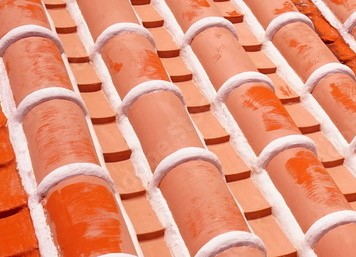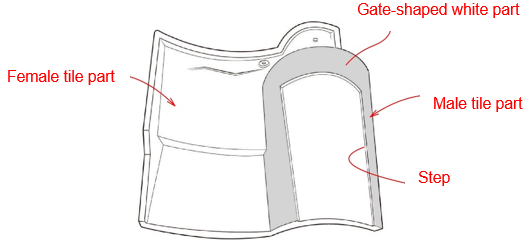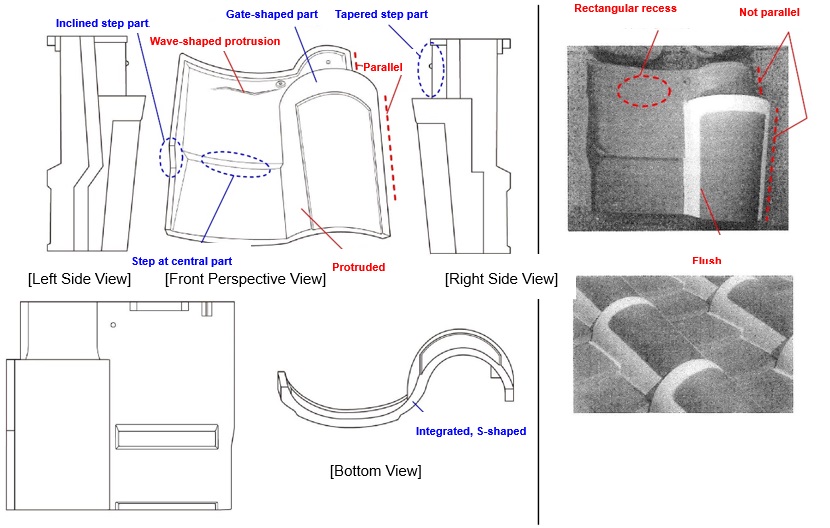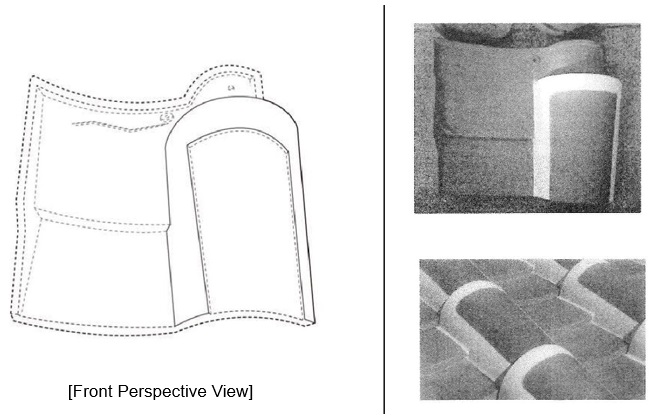2023.12.28
Invalidation Trials for Two Registered Designs for “Roof Tile” s Concluded to Maintain Entire Design and to Invalidate Partial Design
DESIGN
Invalidation Trials for Two Registered Designs for “Roof Tile” s Concluded to Maintain Entire Design and to Invalidate Partial Design
1. Background of Cases
First, we explain the background of the subject invalidation trial cases (Invalidation Trial No. 2021-880006 and Invalidation Trial No. 2021-880007).
The concerned parties of the cases are as follows:
Roof Tile Manufacturer A (Appellee) VS Roof Tile Manufacturer B, Designer’s Office C (Appellant), and Construction Company D (Appellant)
As a designer for a new government office building of a local city hall, Designer’s Office C was selected. C announced that traditional “red roof tiles” (with unknown structure) would be used for the roof of the new government office building.
First, we explain the background of the subject invalidation trial cases (Invalidation Trial No. 2021-880006 and Invalidation Trial No. 2021-880007).
The concerned parties of the cases are as follows:
Roof Tile Manufacturer A (Appellee) VS Roof Tile Manufacturer B, Designer’s Office C (Appellant), and Construction Company D (Appellant)
As a designer for a new government office building of a local city hall, Designer’s Office C was selected. C announced that traditional “red roof tiles” (with unknown structure) would be used for the roof of the new government office building.

[Illustration of Traditional Red Roof Tiles]
Roof Tile Manufacturer A devised a novel roof tile (X) to be used for the roof of the new government office building, so as to reduce the labor and costs for application of the traditional “red roof tiles.” Hereinafter, the background will be explained in a time-series manner.
Nov 21, 2016: A presented (X) to C for commercial purpose.
★Feb 16, 2017:A sent photos and a pamphlet of (X) electronically to the City Hall.
A sent the photos and the pamphlet of (X) electronically to C.
Feb 19, 2017: C explained about use of A’s roof tile in the citizen information session.
Spring 2017: A proposed (Y), modified roof tile of (X), to C.
Apr 24, 2017: A sent drawings of (Y) electronically to C.
Jun 2017: A started endurance tests of (Y)
Mar 30, 2018: D submitted drawings of the new government office building using (Y) to the City Hall.
Jan 10, 2019: A filed a patent application for the invention of the roof tile structure (Roof Tile (Z) modified from (Y)).
Nov 2019: D selected B (not A) as the roof tile supplier for the new government office building.
Dec 2019: A issued a warning to B so that B would stop working the invention of the roof tile based on the patent application.
A filed a petition against B for provisional disposition based on the unfair competition related to (Y).
C and D got involved for supporting intervention on the side of B.
Feb 14, 2020: A filed Design Application No. 2020-002824 for the entire design of (Z) (application changed from a patent application).
May 19, 2020: A filed Design Application No. 2020-009785 for a partial design of (Z) (application changed from a patent application).
June 30, 2020: A acquired the right for the entire design of (Z) (Design Registration No. 1663938).
Aug 13, 2020: A filed a petition against B for provisional disposition based on the design right for (Z).
C and D got involved for supporting intervention on the side of B.
Oct 2, 2020: A acquired the right for the partial design of (Z) (Design Registration No. 1670710).
Nov 6, 2020: For the petition for provisional disposition based on the unfair competition related to (Y), injunction with limited term was determined.
Mar 30, 2021: For the petition for provisional disposition based on the design right for (Z), denial of the petition was determined.
May 18, 2021: C and D filed invalidation trials against A’s two design registrations.
The roof tiles created by Roof Tile Manufacturer A are as follows (novel features as compared to prior designs are underlined).
Roof Tile (X): roof tile in red and white, with Structure 1 and Structure 2, with a small width of the white part, without a step ← not registered as design registration, *mentioned as cited reference in the invalidation trials.
Roof Tile (Y): roof tile in red and white, with Structure 1 and Structure 2, with a large width of the white part, without a step ← not registered as design registration.
Roof Tile (Z): roof tile in red and white, with Structure 1 and Structure 2, with a large width of the white part, with a step ← registered as design registration, *subject of the invalidation trials.
*Structure 1: a male tile part (semi-cylindrical part in the right) and a female tile part (convex-shaped part in the left) are integral.
*Structure 2: a gate-shaped part in the male tile part is in white.
*The width of the white part refers to the width of the white part of the gate-shaped part.
*The step refers to a difference in height at a boundary between the gate-shaped white part and the remaining part of the male tile part.

2. Invalidation Trials
There are the following two reasons for the invalidation trials (common between the entire design and the partial design).
Reason 1: violation of novelty
The subject design fails to comply with the novelty requirement, because it is similar to Roof Tile (X) illustrated by the photos etc. sent electronically from Roof Tile Manufacturer A to the City Hall and the Appellant Designer’s Office C (as indicated with ★ in the time-series event list above).
Reason 2: violation of joint application
Since the representative of Designer’s Office C provided the idea for the subject design as for Roof Tile (X), Designer’s Office C is a joint creator of the subject design. Therefore, the subject application violates joint application, because it was filed and registered without approval of C.
[1] Entire Design
■Reason 1
Supplement: The cited design was disclosed by the Appellee Roof Tile Manufacturer A to the City Hall and Designer’s Office C. However, there is no fact that a confidentiality agreement was concluded between A, and the City Hall and C, and there was no indication of “confidential” in the materials. Therefore, the cited design was regarded as a publicly-known design, and was not excluded from cited references.
(1) Comparison of Designs
[Entire Design: Roof Tile (Z)] [Cited Design: Roof Tile (X)]

Aspects of the left surface, the right surface, the rear surface, and the bottom surface of the cited design are unclear, because only the photos above are available.
(2) Excerpt of Reasons for Judgment of Appeal Board (Outline)
Consumers of the roof tiles are construction companies performing the roofing work using roof tiles, and clients of the roofing work. Since the construction companies pay attention to the installation of the roof tiles and a method of bonding with parts where the roof tiles are not installed in the roofing work, they pay attention to the rear surface of the roof tile. Further, since roof tiles are combined consecutively in the up-and-down direction and the right-and-left direction, they pay attention also to the bottom surface and both the right and left side surfaces of the roof tiles to observe the roof tiles from all directions. Thus, in judgment of the similarity between the two designs, the shape of each part of the roof tile is evaluated from all directions, from the consumers’ perspective.
A consumer observes a roof tile from all directions, that is, pays attention also to the bottom surface and both the right and left side surfaces thereof. Comparing with the cited design with unknown shapes of such surfaces, Differences 2 (left side surface), 3 (right side surface), and 4 (bottom surface) give great influences on the similarity judgment between the two designs.
(2) Excerpt of Reasons for Judgment of Appeal Board (Outline)
Consumers of the roof tiles are construction companies performing the roofing work using roof tiles, and clients of the roofing work. Since the construction companies pay attention to the installation of the roof tiles and a method of bonding with parts where the roof tiles are not installed in the roofing work, they pay attention to the rear surface of the roof tile. Further, since roof tiles are combined consecutively in the up-and-down direction and the right-and-left direction, they pay attention also to the bottom surface and both the right and left side surfaces of the roof tiles to observe the roof tiles from all directions. Thus, in judgment of the similarity between the two designs, the shape of each part of the roof tile is evaluated from all directions, from the consumers’ perspective.
A consumer observes a roof tile from all directions, that is, pays attention also to the bottom surface and both the right and left side surfaces thereof. Comparing with the cited design with unknown shapes of such surfaces, Differences 2 (left side surface), 3 (right side surface), and 4 (bottom surface) give great influences on the similarity judgment between the two designs.
| Similarity | Aspect | Influence on similarity judgment and reason therefor | |
| 1 | Integration of the male tile part and the female tile part, and S-shape in the bottom view | Small | Being publicly known |
| 2 | Tapering step part in the upper part of the male tile part | Small | Being publicly known |
| 3 | Step at the central part of the female tile part | Small | Being publicly known |
| 4 | Entire gate-shaped part | Large | Giving aesthetic impression |
| 5 | Inclined step part in the side wall of the female tile part | Small | Being publicly known |
| 6 | Aspect ratio of the entire tile of approx. 1:1.1 | Small | Being publicly known |
Although Similarity 4 gives a great influence on the similarity judgment between the two designs, the other similarities give small influences on the similarity judgment. Thus, taking all the similarities together into consideration, it is considered that the similarities give small influences on the similarity judgment.
| Difference | Aspect | Influence on similarity judgment and reason therefor | |
| 1 | Specific aspect of the rear surface / unknown in the cited reference | Large | Being noticeable at glance |
| 2 | Specific aspect of the left side surface / unknown in the cited reference | Large | Being observed from all directions |
| 3 | Specific aspect of the right side surface / unknown in the cited reference | Large | Being observed from all directions |
| 4 | Specific aspect of the bottom surface / unknown in the cited reference | Large | Being observed from all directions |
| 5 | Gate-shaped part: protruding in the subject design / flush in the cited reference | Medium | Being conspicuous |
| 6 | Right sides of the female tile part and the male tile part: parallel with each other in the subject design / not parallel in the cited reference | Small | Not being conspicuous |
| 7 | The upper part of the female tile part: wave-shaped protrusion in the subject design /rectangular recess in the cited reference | Small | Being slight difference |
| 8 | Containing no color in the subject design / containing color (red base and white gate-shaped part) in the cited reference | Small | Colors of cited reference being common |
Differences 1-5 generally give great influences on the similarity judgment between the two designs. Even considering Differences 6-8 to have small influence on the similarity judgment, the differences taken together into consideration are recognized to give great influences on the similarity judgment.
In view of the points above, although the subject design and the cited design are the same in relevant articles, the subject design is not similar to the cited design, because, for the aspect, the differences between the two designs have great influences on the similarity judgment, while the similarities therebetween have small influences on the similarity judgment, and subvert the aesthetic impression given to consumers by the similarities to give the impression that the subject design is different from the cited design.
■Reason 2
It was argued that the representative of C had come up with the idea of roofing using red roof tiles with white patterns, based on the provided facts. However, only the lower part of the roof tile is in white, and the aspect of coloring the gate-shaped part in white was not provided. Further, although it was argued that the representative of C had instructed A to protrude the gate-shaped part, there was no specific and exact instruction by drawings. Thus, it is not recognized that the representative of C had created the subject design.
As discussed above, since it is not considered that the representative of C had created the subject design, C does not have the right for the design registration, and it is not considered that the subject registered design was filed in violation of joint application.
■Conclusion
Reasons 1 and 2 for invalidation are groundless, and therefore, the subject design registration cannot be invalidated.
[2] Partial Design (Claiming for Gate-shaped Part)
■Reason 1
(1) Comparison of Designs
[Partial Design: Roof Tile (Z)] [Cited Design: Roof Tile (X)]
In view of the points above, although the subject design and the cited design are the same in relevant articles, the subject design is not similar to the cited design, because, for the aspect, the differences between the two designs have great influences on the similarity judgment, while the similarities therebetween have small influences on the similarity judgment, and subvert the aesthetic impression given to consumers by the similarities to give the impression that the subject design is different from the cited design.
■Reason 2
It was argued that the representative of C had come up with the idea of roofing using red roof tiles with white patterns, based on the provided facts. However, only the lower part of the roof tile is in white, and the aspect of coloring the gate-shaped part in white was not provided. Further, although it was argued that the representative of C had instructed A to protrude the gate-shaped part, there was no specific and exact instruction by drawings. Thus, it is not recognized that the representative of C had created the subject design.
As discussed above, since it is not considered that the representative of C had created the subject design, C does not have the right for the design registration, and it is not considered that the subject registered design was filed in violation of joint application.
■Conclusion
Reasons 1 and 2 for invalidation are groundless, and therefore, the subject design registration cannot be invalidated.
[2] Partial Design (Claiming for Gate-shaped Part)
■Reason 1
(1) Comparison of Designs
[Partial Design: Roof Tile (Z)] [Cited Design: Roof Tile (X)]

(2) Excerpt of Reasons for Judgment of Appeal Board (Outline)
| Similarity | Aspect | Influence on similarity judgment and reason therefor | |
| 1 | Entire gate-shaped part | Large | Giving aesthetic impression |
Since Similarity 1 gives common aesthetic impression through the consumers’ vision, it is considered to have a great influence on the similarity judgment.
| Difference | Aspect | Influence on similarity judgment and reason therefor | |
| 1 | Gate-shaped part: protruding in the subject design / flush with other surface in the cited reference | Medium | Being conspicuous |
| 2 | Containing no color in the subject design / containing color (red base and white gate-shaped part) in the cited reference | Small | Colors of cited reference being common |
For Difference 1, since the gate-shaped part is formed on a surface of the male tile part and is conspicuous, a certain degree of influence on the similarity judgment is recognized. However, for Difference 2, the colors used in the cited design are common and are not considered to attract attention.
In view of the points above, the subject design and the cited design are common both in the articles and the use and function of the part subject to the design registration, which has a great influence on the similarity judgment between the two designs. Also for the aspect, the influence of Difference 1 on the similarity judgment is recognized to some degree, but Difference 2 has a small influence on the similarity judgment. As compared to these differences, Similarity 1 has a great influence on the similarity judgment between the two parts, by giving common aesthetic impression through the consumers’ vision. Therefore, the subject design is similar to the cited design.
■Reason 2
Same as in the entire design as discussed above.
3. Conclusion
The subject cases are complicated, because they were derived from cases for provisional disposition based on the unfair competition and the design rights and involved several modified designs and patent applications. We consider that these cases were harsh for Roof Tile Manufacturer A. The JPO, maybe in view of A’s efforts for creation, issued a trial decision to maintain the entire design and invalidate the partial design. The subject cases concluded in such a way because there was no photo or drawing to clarify the aspect other than the front view of the cited design, but it is assumed that actually it was also similar in the rear surface and both the right and left side surfaces, as it was a modified product of A. There remain some doubts in the following issues: the trial decision for the entire design determined the subject design to be not similar to the cited design by deeming the part not presented in the cited design as “a substantial part of the design” which gives a great influence on the similarity judgment; and the trial decision for the entire design determined the gate-shaped part which is the most conspicuous part in the front view not to subvert the differences, while the trial decision for the partial design recognized the gate-shaped part as “the substantial part of the design” to invalidate the subject design.
Reviewing the cases, fundamentally, A should have concluded a confidentiality agreement or attached indication of “confidential” to documents in disclosing their novel creation to outside parties (C and the City Hall). Further, even if A could not file the design application prior to the disclosure to C and the City Hall, A should have taken a procedure for exception to lack of novelty and filed an application for initially-designed Roof Tile (X), and also should have filed design applications for Roof Tiles (Y) and (Z) resulting from modifications as relevant designs.
As the sequel to the subject cases, the Appellants of the invalidation trials filed a lawsuit for canceling the trial decision against the trial decision to maintain the entire design. The Intellectual Property High Court’s Decision determined that the entire design was similar to the cited design to cancel the trial decision.
The gist of such a determination is that Reason 2 for invalidation based on the violation of joint application is groundless, but Reason 1 for invalidation based on the violation of novelty is grounded. We will explain detailed judgment of the IPHC in other opportunities.
4. Source of Quotation and Materials
Source of quotation of the illustrations of the traditional red roof tile:
https://web.archive.org/web/20211123001519/https://www.y-mainichi.co.jp/news/37986/
Publication of Design Registration No. 1663938 (entire design)
https://www.j-platpat.inpit.go.jp/c1800/DE/JP-2020-002824/36476B40643A8432D187BAABB25B922929948EE57AFA03279C4AD3E83348E312/30/en
Publication of Design Registration No. 1670710 (partial design)
https://www.j-platpat.inpit.go.jp/c1800/DE/JP-2020-009785/9B02E6BCED19AEE93AFFE3B0F00835FC83B3971B39AEB065F88FC2D99C4CD5C8/30/en
Kaori KYOMURA, Patent Attorney
kaori. kyomura@rc-iplaw.com
In view of the points above, the subject design and the cited design are common both in the articles and the use and function of the part subject to the design registration, which has a great influence on the similarity judgment between the two designs. Also for the aspect, the influence of Difference 1 on the similarity judgment is recognized to some degree, but Difference 2 has a small influence on the similarity judgment. As compared to these differences, Similarity 1 has a great influence on the similarity judgment between the two parts, by giving common aesthetic impression through the consumers’ vision. Therefore, the subject design is similar to the cited design.
■Reason 2
Same as in the entire design as discussed above.
3. Conclusion
The subject cases are complicated, because they were derived from cases for provisional disposition based on the unfair competition and the design rights and involved several modified designs and patent applications. We consider that these cases were harsh for Roof Tile Manufacturer A. The JPO, maybe in view of A’s efforts for creation, issued a trial decision to maintain the entire design and invalidate the partial design. The subject cases concluded in such a way because there was no photo or drawing to clarify the aspect other than the front view of the cited design, but it is assumed that actually it was also similar in the rear surface and both the right and left side surfaces, as it was a modified product of A. There remain some doubts in the following issues: the trial decision for the entire design determined the subject design to be not similar to the cited design by deeming the part not presented in the cited design as “a substantial part of the design” which gives a great influence on the similarity judgment; and the trial decision for the entire design determined the gate-shaped part which is the most conspicuous part in the front view not to subvert the differences, while the trial decision for the partial design recognized the gate-shaped part as “the substantial part of the design” to invalidate the subject design.
Reviewing the cases, fundamentally, A should have concluded a confidentiality agreement or attached indication of “confidential” to documents in disclosing their novel creation to outside parties (C and the City Hall). Further, even if A could not file the design application prior to the disclosure to C and the City Hall, A should have taken a procedure for exception to lack of novelty and filed an application for initially-designed Roof Tile (X), and also should have filed design applications for Roof Tiles (Y) and (Z) resulting from modifications as relevant designs.
As the sequel to the subject cases, the Appellants of the invalidation trials filed a lawsuit for canceling the trial decision against the trial decision to maintain the entire design. The Intellectual Property High Court’s Decision determined that the entire design was similar to the cited design to cancel the trial decision.
The gist of such a determination is that Reason 2 for invalidation based on the violation of joint application is groundless, but Reason 1 for invalidation based on the violation of novelty is grounded. We will explain detailed judgment of the IPHC in other opportunities.
4. Source of Quotation and Materials
Source of quotation of the illustrations of the traditional red roof tile:
https://web.archive.org/web/20211123001519/https://www.y-mainichi.co.jp/news/37986/
Publication of Design Registration No. 1663938 (entire design)
https://www.j-platpat.inpit.go.jp/c1800/DE/JP-2020-002824/36476B40643A8432D187BAABB25B922929948EE57AFA03279C4AD3E83348E312/30/en
Publication of Design Registration No. 1670710 (partial design)
https://www.j-platpat.inpit.go.jp/c1800/DE/JP-2020-009785/9B02E6BCED19AEE93AFFE3B0F00835FC83B3971B39AEB065F88FC2D99C4CD5C8/30/en
Kaori KYOMURA, Patent Attorney
kaori. kyomura@rc-iplaw.com
